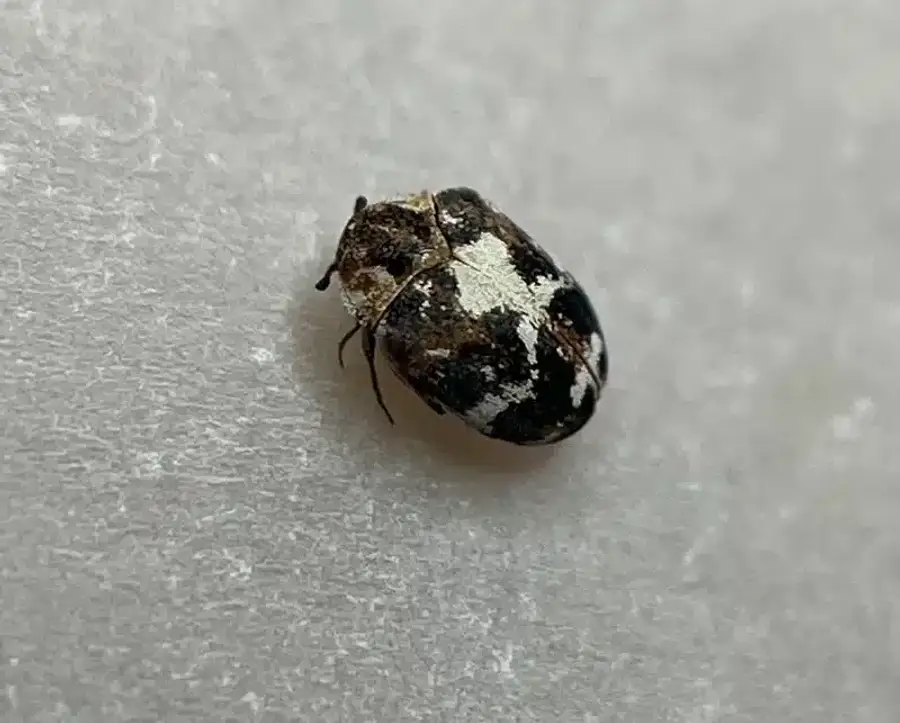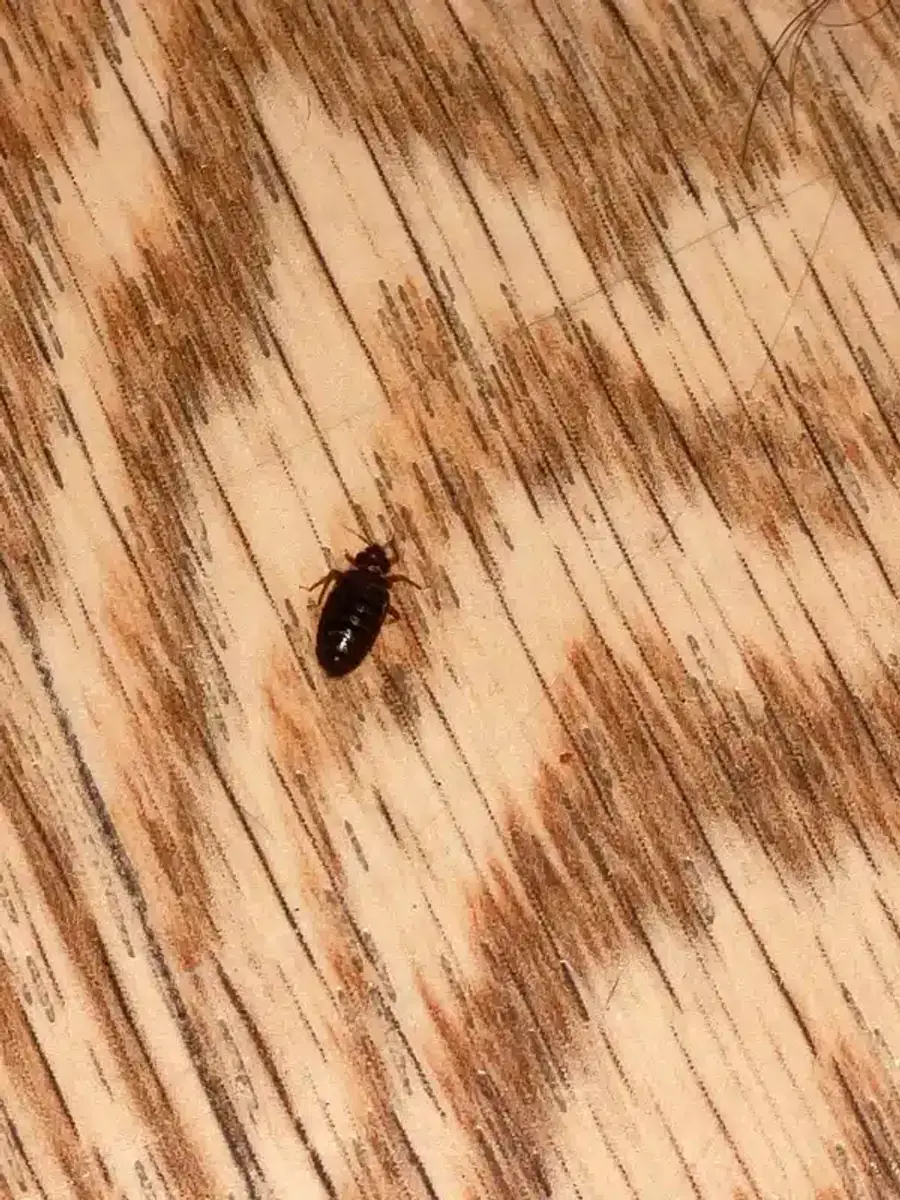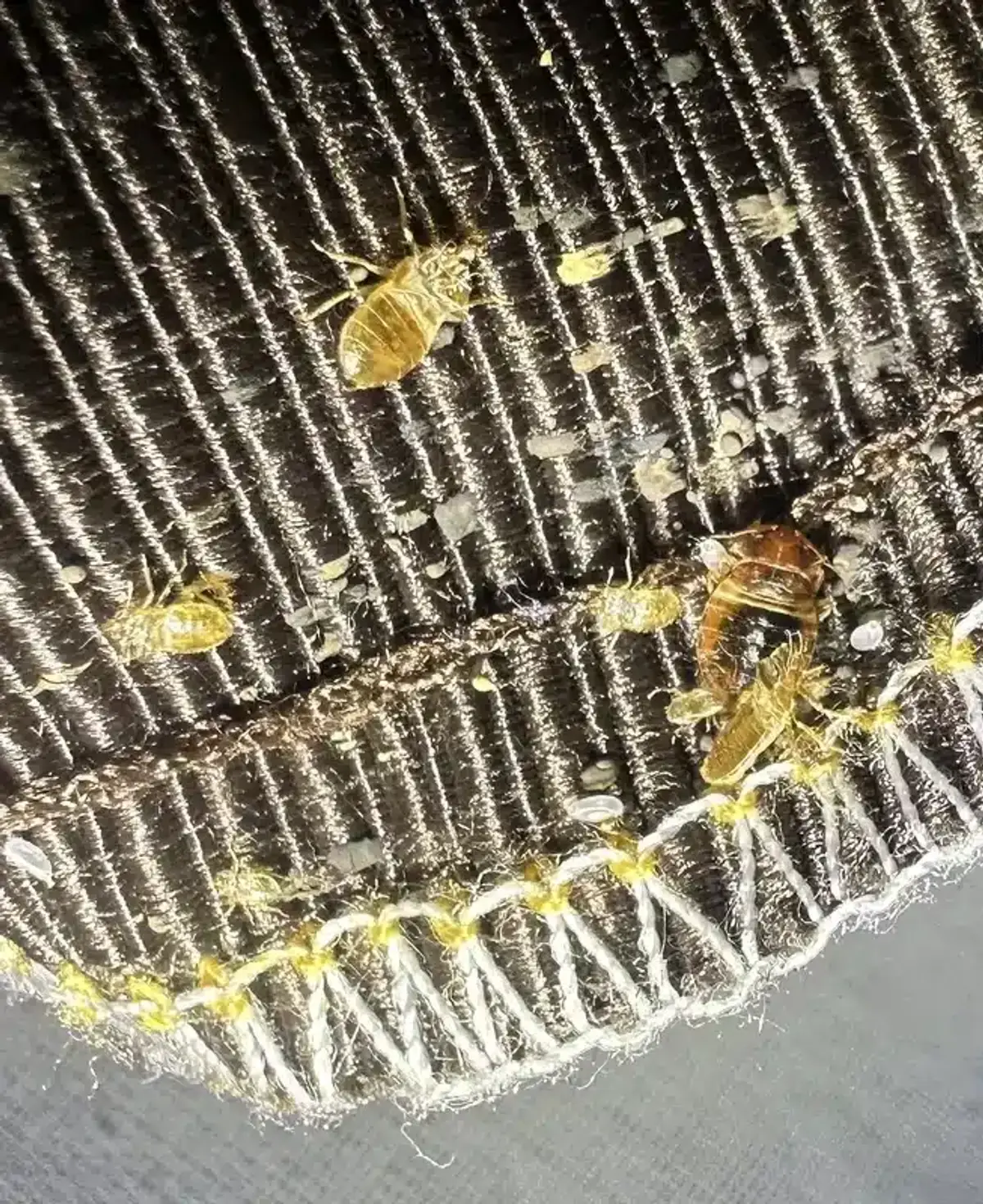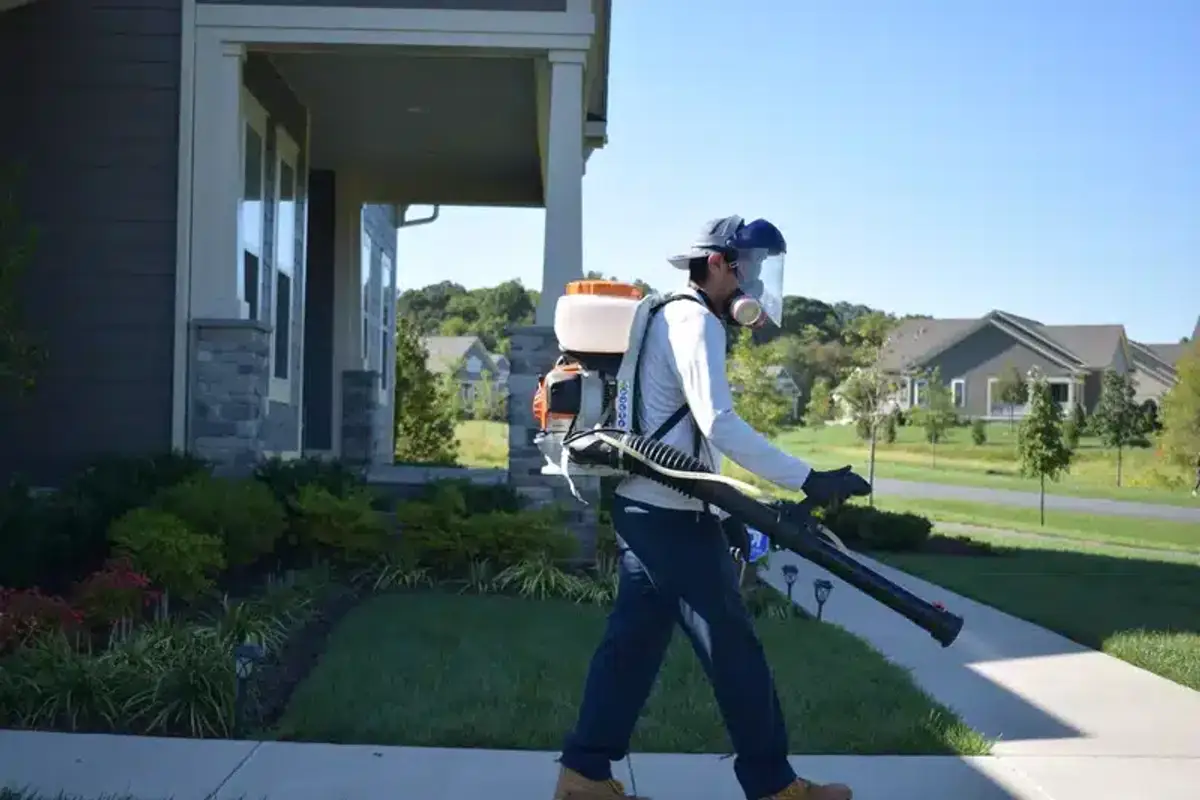Finding mysterious bites on your skin or tiny holes in your clothes can be alarming. Many homeowners in Virginia and Maryland call us wondering whether they’re dealing with bed bugs or carpet beetles. After four years as a registered technician helping families in the DMV area, I’ve seen this confusion countless times.
The key difference is simple: bed bugs bite people and hide near beds, while carpet beetles eat fabric and hide in dark corners. However, distinguishing between these pests requires looking at several factors including their appearance, damage patterns, and hiding spots.

Physical Appearance: Carpet Beetle vs Bed Bug
The easiest way to tell these pests apart is by their size and shape. Adult carpet beetles are typically smaller than bed bugs, measuring less than 6mm (about 1/4 inch) long. They have an oval, convex shape and are often mottled with white, brown, and yellow scales.
Bed bugs are larger, measuring 4-7mm (about the size of an apple seed). They have a flat, wingless body when unfed and are reddish-brown in color.
What does the science say?
According to the Centers for Disease Control and Prevention (CDC), bed bugs are reddish-brown, oval, and flat insects about the size of an apple seed. The CDC notes that bed bugs are active mainly at night and are attracted to warmth and carbon dioxide. They can live for several months without feeding and can survive temperatures from freezing to over 122°F (50°C).


Carpet Beetle Larva vs Bed Bug Nymphs
Carpet beetle larvae look completely different from adult beetles. These fuzzy, carrot-shaped creatures measure 2-6mm and are covered with tufted, spear-shaped hairs. Many homeowners mistake these larvae for tiny caterpillars.
Bed bug nymphs, on the other hand, look like smaller versions of adults. They start translucent-yellow and become progressively darker after feeding. The youngest nymphs are so small they can pass through a credit-card gap.
| Bed Bugs | Carpet Beetles | |
|---|---|---|
| Size | 4-7mm (apple seed) | Less than 6mm |
| Shape | Flat, oval | Round, convex |
| Diet | Blood only | Natural fibers |
| Damage | Bites, blood spots | Holes in fabric |
| Location | Near beds | Dark corners |

Signs of Carpet Beetles vs Bed Bug Damage
This is where the carpet beetle vs bed bug difference becomes most obvious. These pests have completely different diets and cause entirely different types of problems in your home.
What Carpet Beetles Eat
Carpet beetle larvae are the real troublemakers. They digest keratin and other animal proteins found in wool rugs, wool-blend clothing, furs, feathers, and even pet food. They can also feed on taxidermy, felt pads, and animal nests.
What does the science say?
The Virginia Tech Extension explains that carpet beetle larvae specifically target materials containing keratin, a protein found in animal-based products. Their research shows that larvae can develop on surprisingly diverse food sources including bird nests, dead insects in light fixtures, and even accumulated pet hair. The university notes that complete development from egg to adult can take 2-3 years in unheated areas but occurs much faster in warm indoor environments.
The fabric damage appears as irregular, scattered holes with shredded or thread-bare edges. You’ll often find the carpet nap clipped down to the backing, along with cast larval skins nearby.
What Bed Bugs Eat
Bed bugs are obligate blood feeders, meaning they only feed on blood. They don’t eat fabric at all. Instead, they draw blood in 3-7 minutes, leaving reddish punctures that can form wheals on your skin.
The indirect damage from bed bugs includes rusty blood spots on sheets, black fecal specks on mattresses, and shed nymphal skins near beds. You won’t find any holes in your clothing from bed bugs.
Tell the Difference: Bed Bug Bites vs Carpet Beetle Reactions
Many people confuse carpet beetle skin reactions with bed bug bites. However, understanding the difference can help you identify which pest you’re dealing with.
Bed Bug Bite Patterns
Bed bug bites often appear in characteristic “breakfast-lunch-dinner” linear or clustered patterns on exposed skin. The reactions vary widely - some people show no symptoms while others develop itchy wheals or, rarely, severe allergic reactions.
These bites typically show up on arms, shoulders, neck, and face - areas exposed while sleeping. The bites usually appear within hours or days of feeding.
Carpet Beetle Skin Reactions
Carpet beetle larvae don’t actually bite. Instead, contact with their airborne hairs causes scattered papules or rash-like reactions. These typically appear as single lesions on limbs or face, sometimes accompanied by respiratory symptoms in sensitive individuals.
The key difference: patterned bites plus blood spots indicate bed bugs, while random skin irritation without feeding evidence suggests carpet beetles.
Where to Look for Bed Bugs vs Carpet Beetles
Knowing where to look is crucial for proper identification in your carpet beetle vs bed bug investigation.
Signs of Carpet Beetles in Your Home
Carpet beetle larvae prefer dark, undisturbed areas with lint or food sources. Common hiding spots include:
- Under baseboards and in floor cracks
- Inside HVAC vents and ductwork
- Attics with bird or bat nests
- Stored woolens and holiday decorations
- Pet food storage areas
Adult carpet beetles gravitate toward sunny windows, especially during spring emergence from April to July in Virginia and Maryland.

Signs of Bed Bug Infestations
Bed bugs prefer staying within 8 feet of sleeping hosts. According to the University of Maryland Extension, key hiding places include:
- Mattress seams and box spring covers
- Bed frames and headboards
- Behind baseboards near beds
- Picture frames and wall decorations
- Paper clutter and electronics (in heavy infestations)
When Carpet Beetles and Bed Bugs Are Most Active
Understanding when these pests are most active helps with identification and prevention efforts.
Carpet Beetle Seasons
Adult carpet beetles emerge primarily from April through July in the Mid-Atlantic region. They fly in from flowering plants or hitchhike on cut flowers and bird nests before establishing indoors. The larval stage can last 3-36 months depending on indoor temperatures, allowing year-round activity in heated homes.
Bed Bug Activity
Bed bugs remain active year-round in heated buildings. With 3+ generations possible annually indoors, activity patterns don’t follow seasonal rhythms. They disperse passively through luggage, second-hand furniture, and shared walls in multi-family housing throughout the year.
Treatment Approaches: Carpet Beetle vs Bed Bug
Effective treatment strategies differ significantly between these pests. Our family business has been serving the DMV area for over 50 years, and we’ve learned that proper identification leads to more successful treatments.
Carpet Beetle Treatment
Carpet beetle control focuses on sanitation and exclusion:
- Deep vacuuming of cracks, vents, and upholstered furniture
- Heat treatment of infested items (120°F for 1 hour)
- Freezing treatment (0°F for 72+ hours)
- Targeted residual applications in cracks and crevices
- Source elimination including bird nests and stored food
We focus on prevention over broadcast spraying, using products like cyfluthrin or bifenthrin only in targeted applications after thorough cleaning.

Bed Bug Removal Methods
Bed bug control requires a more aggressive, multi-faceted approach. The EPA recommends integrated pest management including:
- Heat treatment (122°F for 90+ minutes)
- Steam treatment (160°F) for seams and cracks
- Mattress encasements and clutter removal
- Targeted insecticide applications using multiple chemical classes
- Follow-up monitoring for 90+ days post-treatment
Important note: Our comprehensive pest control plans cover many insects, but bed bugs require specialized treatment programs due to their resistance patterns and treatment complexity.
How to Prevent Bed Bug and Carpet Beetle Infestations
Preventing these pests requires different approaches based on their entry methods and preferences.
Essential Prevention Steps
- For Bed Bugs: Inspect hotel rooms before settling in, store luggage in sealed bags, and check second-hand furniture thoroughly before bringing it home.
- For Carpet Beetles: Seal gaps around windows, store woolens in airtight containers, and vacuum regularly to remove lint and debris.
- Universal Prevention: Regular professional inspections can catch early infestations before they become major problems.
- Emergency Response: If you suspect either pest, avoid moving items to uninfested areas until professional identification is complete.
Carpet Beetle Prevention
Focus on exclusion and habitat modification:
- Seal gaps around window air conditioning units
- Inspect thrift store furniture before bringing indoors
- Store woolens in airtight containers during humid summers
- Remove bird nests from exterior areas
- Regular vacuuming of carpets and upholstered furniture
Bed Bug Prevention
Emphasize travel precautions and inspection habits:
- Inspect hotel rooms before settling in
- Unload luggage on hard surfaces after travel
- Dry-cycle clothes on high heat for 30 minutes
- Store suitcases in sealed bags
- Inspect second-hand furniture thoroughly
Professional Pest Control for Bed Bugs and Carpet Beetles
While some carpet beetle situations can be managed with thorough cleaning, both pests often require professional intervention for complete elimination.
In my experience serving Virginia and Maryland homeowners, DIY treatments frequently fall short because people misidentify the pest or miss key hiding spots. Professional registered technicians have the tools and products needed for thorough treatment.
Additionally, our team has removed 9 of the harshest chemicals common in the industry, choosing alternatives like Essentria and Alpine that we’d feel comfortable using in our own homes.
Professional Advantage
Misidentification leads to wrong treatments and wasted money. Our experienced technicians can distinguish between carpet beetles and bed bugs in minutes, ensuring you get the right treatment the first time. Plus, we use safer alternatives to the harshest chemicals in the industry.
Understanding the difference between carpet beetles and bed bugs is crucial for effective treatment and peace of mind. Whether you’re dealing with mysterious skin reactions or unexplained fabric damage, proper identification leads to better outcomes and less frustration.
If you’re still uncertain about which pest you’re facing, or if you need professional treatment for either carpet beetles or bed bugs, call us at 703-683-2000 or email us at info@bettertermite.com. Our registered technicians can perform a thorough inspection and develop an appropriate treatment plan using products we’d feel comfortable using in our own homes.
Frequently Asked Questions
Here are the most common questions we hear when homeowners notice mysterious bites or fabric damage:
Do carpet beetles bite like bed bugs?
+
No, carpet beetles don't bite. However, their larvae have tiny hairs that can cause skin irritation resembling bites. This reaction appears as scattered red bumps rather than the linear patterns typical of bed bug bites.
Can you have both carpet beetles and bed bugs at the same time?
+
Yes, it's possible to have both pests simultaneously since they have different food sources and hiding preferences. Carpet beetles focus on natural fibers while bed bugs seek blood meals, so they don't compete directly with each other.
How quickly can I tell the difference between carpet beetle vs bed bug damage?
+
Usually within a day or two of careful observation. Check for holes in natural fiber clothing or carpets (carpet beetles) versus blood spots on sheets and bite patterns on skin (bed bugs). The damage types are quite different once you know what to look for.
Are carpet beetles harder to get rid of than bed bugs?
+
Generally, carpet beetles are easier to eliminate because they respond well to thorough cleaning and don't have the same resistance issues as bed bugs. However, finding all their food sources and hiding spots can be challenging without professional help.
Do carpet beetles prefer certain fabrics over others?
+
Yes, carpet beetle larvae prefer natural animal fibers like wool, silk, fur, and feathers. They rarely damage synthetic materials unless they're heavily soiled with food particles or body oils that contain proteins.
Can bed bugs cause fabric damage like carpet beetles?
+
No, bed bugs only feed on blood and don't eat fabric. Any holes in clothing or carpets indicate a different pest, likely carpet beetles or clothing moths. Bed bugs only leave blood spots and dark fecal stains on bedding.
How long does carpet beetle vs bed bug treatment typically take?
+
Carpet beetle treatment often shows results within 2-4 weeks with proper sanitation and targeted applications. Bed bug elimination typically requires 2-6 weeks with multiple treatments and ongoing monitoring for at least 90 days.
Should I be more concerned about carpet beetles or bed bugs?
+
Both pests cause significant frustration, but bed bugs typically create more stress due to their biting behavior and sleep disruption. Carpet beetles cause property damage but don't affect your daily comfort as dramatically. Either pest warrants prompt professional attention.
With five years of hands-on experience in the pest control industry, George Schulz is a registered technician with the Virginia Pest Management Association and a proud third-generation professional in a family business that's been protecting homes for over 57 years. He manages and trains a team of service pros while also leading internal research efforts—recently spearheading a deep-dive review of thousands of documents on pest control materials to hand-pick the most kid and pet friendly, most effective solutions tailored specifically for homes in the DC metro area.
